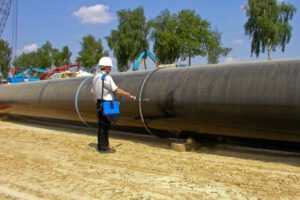There are several types of gas piping inspection. These methods include Ultrasonic Testing, Magnetic Particle Inspection, and Dye Penetrant Testing. Each method can be used to identify different issues, including subsurface or surface damage. Ultrasonic testing uses high-frequency sound waves to measure the wall thickness and full penetration welds. Both are non-destructive. Dye Penetrant Testing, or DPT, is another type of inspection that is used to identify surface damage.

Piping inspections should be performed regularly and thoroughly. Regular inspections are necessary to ensure that the pipes are functioning properly and that the safety of the entire plant is maintained. Typically, piping systems will last for many years, but unexpected conditions can cause degradation or failure. Ongoing maintenance and inspection are essential to avoid catastrophic failure. When performed routinely, piping inspections and maintenance programs can prevent catastrophic failure and enhance plant operations. Here are some of the benefits of performing a piping inspection.
Gas piping must meet specific requirements. For example, the piping must be able to withstand a 10 psi gauge pressure for 15 minutes. The pressure must not drop significantly during this time. Similarly, it must not fall below 60 psi during the test. For the entire process to be successful, the inspection must be performed by a certified LMP. When conducting the inspection, the LMP must sign the certification and state what conditions were corrected.
The proposed rules clarify when and where piping inspections must be performed. They also spell out the penalties for non-compliance. Building gas piping systems must be inspected at least twice a year, in most cases. For buildings classified in occupancy group R-3, inspections must be performed regularly. These buildings can be found on the Certificate of Occupancy (CO).
Gas piping inspections are required by law. These inspections must be performed by a Licensed Master Plumber, who is licensed to perform plumbing work. DOB encourages people and tenants to check the license status of LMPs to ensure they are licensed and have no disciplinary history. For this reason, an LMP should have all the necessary certifications to perform the necessary work. The LMP must also maintain a record of inspections for 10 years.
In cities, the inspection of gas piping systems must be performed every four years by a Licensed Master Plumber (LMP) or a qualified individual working under the license. Inspections must be conducted every four years, according to Local Law 152 of 2016. The inspection must be performed by December 31 of this year or within the fourth calendar year. There are exceptions to this requirement, including buildings in occupancy group R-3. The DOB also enforces that all gas piping inspections must be conducted in buildings.
Local Law 152 (LL152) requires periodic inspections of gas piping systems in buildings. The law is part of a larger package of regulations that aims to ensure the safety of gas lines. By requiring periodic inspections of gas piping systems, LL152 helps prevent several injuries and property damage. The city has a specific procedure for signing and submitting inspection reports. The deadline for gas piping inspections is December 31, 2020.
If you are a landlord, the time to perform periodic inspections is crucial for the safety of your building. You should check your lease to see how often your piping inspections are required. If your building does not meet this requirement, you should consider hiring a professional inspection service. A reputable company will be able to conduct inspections for both residential and commercial properties. When considering whether or not to hire a professional to complete your inspection, make sure to check the certificate of occupancy first.
Hydro testing is another way to find leaks. In this process, the testing engineer fills the piping system with water, evacuates the air, and then presses the material up to 1.5 times its pressure limit. The fluid is then monitored for cracks and leaks. If leaks are discovered, testing engineers may add a fluorescent dye or tracer to the fluid, making it easier to detect them. This way, they can follow where the leak is coming from.